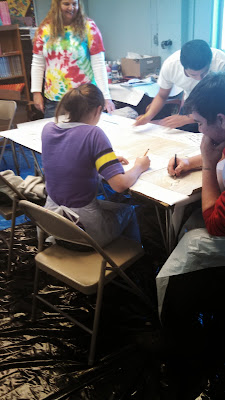We stripped the canes and gesso them white so that the students from TLC could paint them with primary colors. The thatch grass was tied onto the fence that separates the school garden from the 40 arches of corn stalks that surround the school and the neighboring community.
An Art Service Organization - developing projects as living experiments for sustainable practices and an incubator for personal and collective transformation. Visual Arts Development Project, a community-based art organization that provides children, adults, and emerging artists with resources, workshops, and a venue to show and express their art form.
Wednesday, December 18, 2013
Thatch Grass Weavings and Painted Bamboo Installation
We stripped the canes and gesso them white so that the students from TLC could paint them with primary colors. The thatch grass was tied onto the fence that separates the school garden from the 40 arches of corn stalks that surround the school and the neighboring community.
Monday, December 16, 2013
Jumpin Jambalaya Tribute to Grandmother's Circle
| Kucha Brownlee & Baba Tony Brown
CHARLESTON — The public is invited to a reception and storyteller program in the
Tarble Arts Center atrium to close the month-long Arts-in-Education Residency with Alpha Bruton from 5 to 7 p.m. on Thursday. Guest artists and storytellers Baba Tony Brown and D. Kucha Brownlee will present “Jumpin’ Jambalaya,” a diverse program including folk tales, call and response, poetry, and music. Resident artist Alpha Bruton will discuss her installation exhibition, “Grandmother’s Circle,” including how she incorporated works that the students made during the residency into her exhibition. Refreshments will be served. Funding for the residency is provided by a Ruth and Vaughn Jaenike Access to the Arts Grant, the Coles County Arts Council, the participating schools and Tarble Arts Center membership contributions. The Tarble Arts Center is located at 2010 Ninth St. on the EIU campus in Charleston. The center is open from 10 a.m.-5 p.m. Tuesday through Friday; and from 10 a.m. to 4 p.m. Saturday; and from 1 to 4 p.m. Sunday; closed Mondays. For more information, visit www.eiu.edu/tarble/.
A dynamic storytelling duo that combine their experience as performers to weave
a rich tapestry of African,African-American and Spanish folk tales, frolicking fables, proverbs and dialect into their cultural performance art storytelling.
|
Sunday, December 15, 2013
Sound and Video Installation a Narratives
The focus of the installation was the narratives that were given by guest artists that I interviewed. Contributors: Anita P. Lowe, Talver Germany, Diana Bruton, Christine Burks Alum, Antionette Bruton, Toni Collie Perry, Taylor, and Jackie (workshop participants). Gave us great short stories about their grandmothers, and shared memory, the short films were put together randomly and between each segment, we added transitional scenes of driving to Table Mountain in the Pine Flat Dam area of Fresno Co., and my train ride from Chicago to California.
Wednesday, December 11, 2013
Tarble Arts Center Textile Art Workshop
Often referred to as plangi, tie-dyeing is a method of decorating cloth
by isolating areas so that they resist the dye. Instead of coating sections of
the fabric with a “resist” substance, such as wax, in order to isolate them,
areas are bound with thread so that when the fabric is immersed in the dyebath
the tightness of the yarn acts as a barrier to the dye and prevents it from
penetrating to the tied areas. Other methods of tie-dyeing include folding,
sewing or binding small objects such as seeds, pebbles or dried peas into the
cloth.
Tuesday, December 10, 2013
Adinkra Symbology Environmental Installation in Humboldt Illinois
Treatment and Learning Center, Humboldt
Dave Logsdon, Principal; Amy Wettig & Rich Holtz, coordinating teachers, Sean Fairchild (Tarble Arts Center-assistant).
Installation- the students began the residency today by
painting spirit flags using Adinka Symbology. This workshop was conducted by
Caryl Henry Alexander, during "the land" retreat in Auburn
California. We will use the banners as spirit flags, and install them in the
environmental installation.
Week Four, December 9-12th, on Monday, Dec, 9th we had a snow day, the school was closed, so we have to double on workshops to make enough art for the school installation. Today we made spirit flags and started painting our symbols on cardboard.
Adinkra Symbology
The Origin and Meaning of Adinkra Symbols
The adinkra symbols represent popular proverbs and maxims, record historical events, express particular attitudes or behavior related to depicted figures, or concepts uniquely related to abstract shapes.
The Tarble Arts Center, an AAM accredited museum, is a community arts center and Eastern Illinois University’s art museum. The Tarble is located in Charleston, a rural community of 21,500 (including E.I.U. students), 190 miles south of Chicago in east-central Illinois.
The residency is funded by the
Illinois Arts Council, a state agency, by participating schools, the Coles
County Arts Council, and Tarble membership contributions.
Tuesday, December 3, 2013
Ringing of the Bells on Hartman Street
CeCe Antoinette Bruton, my 1st cousin- contributed an Ancestral Tribute to Princella Hartman her grandmother, she was the first person profiled as a Hometown Hero.
Princella Hartman died at the age of 107. Hartman was featured in the first edition of Hometown Heroes in 1995 for her work as a volunteer at Parkland Memorial Hospital in Dallas. Hartman took the bus three days a week to help out mothers and newborns at the hospital. Hartman came to Dallas to run a boarding home during the Great Depression. She also worked as a private cook in homes and for the Dallas Independent School District.
The house Hartman lived in was purchased by her in 1934 and Hartman Street in the State-Thomas district of Uptown is named after her.
http://youtu.be/NKR-VJUn0Ao
http://youtu.be/NKR-VJUn0Ao
Hartman's volunteer efforts resulted in honors from President Barack Obama, George W. Bush, and the City of Dallas. Hartman's family members said she never smoke or drank and exercised daily. Dominoes and reading were some of Hartman's favorite activities. Hartman lived long enough to see six generations of family members.
Read more: http://www.myfoxdfw.com/story/23520119/first-hometown-hero-princella-hartman-dies-at-107?autoStart=true&topVideoCatNo=default&clipId=9342225#ixzz2kSSYnQet
Subscribe to:
Posts (Atom)


.jpg)

